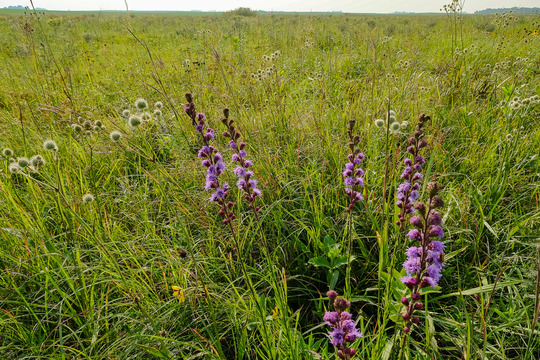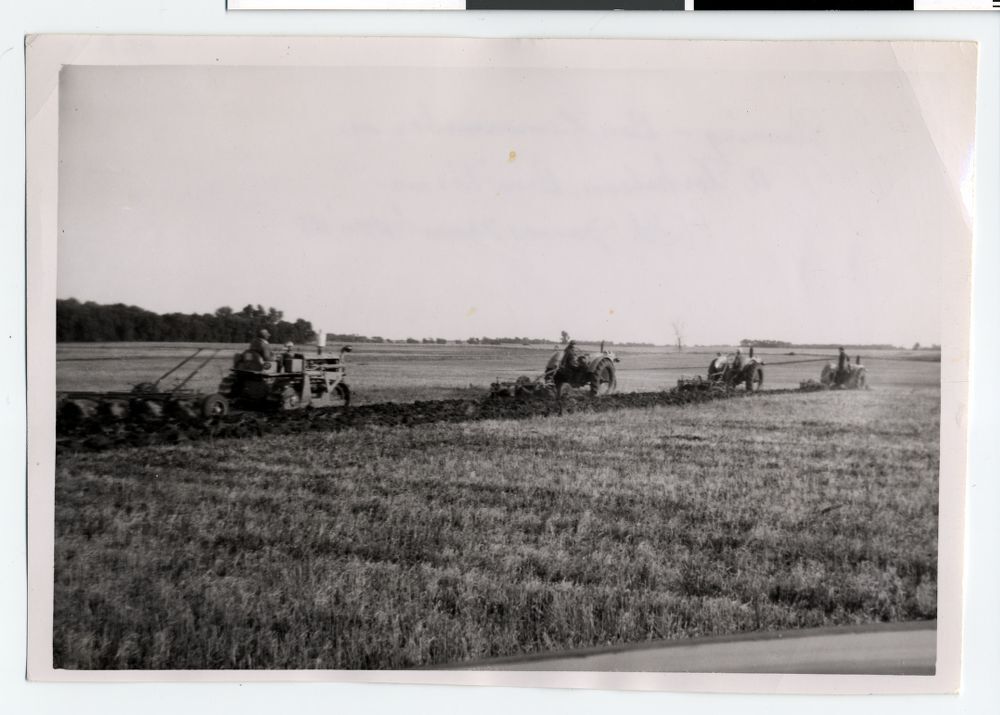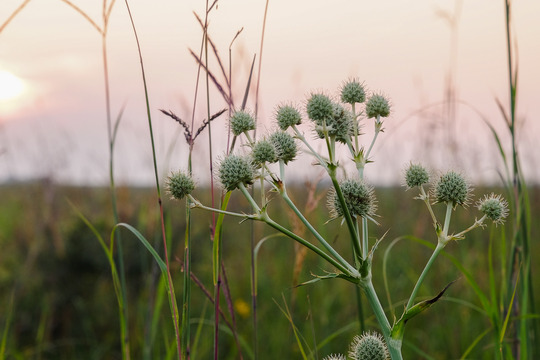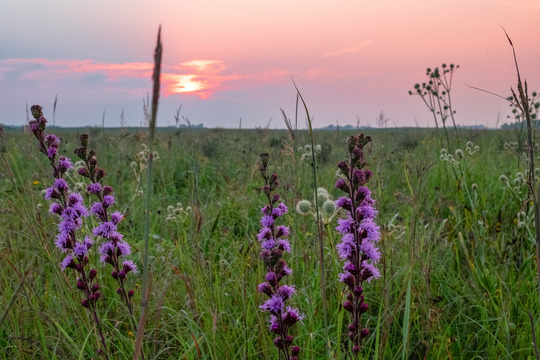|
Fall 2024
NATURE NOTES
Nature Notes is the Minnesota Scientific and Natural Areas Program quarterly newsletter.
In this issue:
|
|
 |
At Butternut Valley Prairie SNA, History and Biodiversity Inspire Prairie Conservation
Justin Vorndran, SNA Communications Outreach Specialist
You can’t miss Butternut Valley Prairie SNA. That’s not just a travel recommendation – it’s an observation that anyone driving through the wide valleys of Blue Earth County will notice. The views are long here, and among a sea of row crops tinted a drab green, the vibrant colors of native prairie plants shine like “a little jewel”, in the words of Brad Bolduan, SNA Prairie Specialist. Butternut Valley Prairie SNA is an 11.5-acre example of native prairie that has all but disappeared from the surrounding area. This remnant prairie holds memories of an ecosystem that once covered western Minnesota, and if prairies could speak, Butternut Valley Prairie would have incredible stories to tell.
 A view of Butternut Valley Prairie SNA in late summer. Photo by Justin Vorndran, MN DNR.
Unfortunately, prairies cannot speak into a microphone or write words on a page. Prairies express themselves in the changing of the seasons and the constant cycle of life, and it takes a special kind of person to notice prairies, act, and advocate for their protection. As I walk into the prairie on a dusty day in late August, I’m waiting to meet with one of those people – someone who noticed this prairie and took action to protect it for future generations.
Wayne Feder is an avid birder and naturalist, and he’s been a nature lover his entire life. Wayne leased Butternut Valley Prairie for over a decade and dedicated his time, money, and energy to protect this native prairie before it caught the eye of Minnesota DNR staff. Without Wayne, Butternut Valley Prairie likely would’ve been turned into cropland, and instead of finding myself surrounded by a diversity of native plant species, I’d be ankle deep in a field of soybeans.
 Wayne Feder at Butternut Valley Prairie SNA. Photo by Justin Vorndran, MN DNR.
Wayne found out about this prairie incidentally. While driving by, he and his wife noticed splashes of vibrant orange in the fields out the car window. It was butterfly-weed, Asclepias tuberosa, a native prairie plant. They stopped the car to look around, and found a diversity of native plants, many of which were uncommon in the area. Wayne immediately understood the significance of what they had discovered. “It was the only prairie that I knew of [in the area] at the time,” he told me. He pulled into the driveway of the nearby farm to discuss the prairie.
The neighbors told Wayne that the prairie had been in their family since the late 1800s, and it had never been tilled for crops. Historically, agriculture relied heavily on livestock, and it was common practice to leave fields for haying and grazing, which is exactly how Butternut Valley Prairie escaped conversion to cropland. Prairie soil is incredibly rich, and it takes hundreds, if not thousands of years to form the biological communities that can be found in remnant prairies. Wayne inquired about the field at just the right time — the neighbors told him that they couldn’t find someone to use the field for hay, so they were considering leasing it to someone who would till it to plant crops. Wayne knew he had to act fast. “I just knew it had to be saved,” he said. He arranged to lease the prairie.
Prairie hasn’t always been so rare in this region of Minnesota. Prairie formed in the Midwest after the most recent glacial episode. As the ice retreated, a number of natural forces came together to form tallgrass prairie. Prairies are sustained by disturbance – American bison would graze the prairie and transport seeds in their fur, and frequent fires, often set by Native Americans, would rejuvenate the landscape. At one point in history, the entire landscape of Southern Minnesota was prairie that looked a lot like Butternut Valley Prairie does today.
The disappearance of Minnesota’s native prairies began with the arrival of settlers and organized agriculture. In the late 1800s, homesteads, towns, and roads connecting them began populating the landscape. Native prairie survived in roadsides, railroad rights-of-way and hayed or grazed fields. In roadsides and rights-of-way, incidental fires and road work accidentally provided the disturbance that sustains native prairie.
Prairie habitat began disappearing rapidly in the 20th century. The increasing prevalence of mechanical farm equipment meant less remnant prairie was needed for grazing, and more crop fields took its place. Pesticide usage increased, invasive species began to degrade native plant communities, and native prairie largely disappeared - even from the roadside ditches.
 Plowing on the Torkelson brothers’ farm, near St. James MN ca. 1947-1948. Courtesy of Watonwan Historical Society.
Not all of the prairie disappeared. Despite the changes taking place across the landscape, the land that would come to be known as Butternut Valley Prairie remained relatively unscathed. In 2006, when this prairie became a candidate for SNA designation, the Minnesota Biological Survey (MBS) assessed Butternut Valley Prairie to understand the ecological features there. They found three uncommon species – all made rare by the cultivation of surrounding habitat: Tuberous Indian plantain (Arnoglossum plantagineum), Sullivant’s milkweed (Asclepias sullivantii), and rattlesnake master (Eryngium yuccifolium). The final verdict on the biodiversity significance of this place? “Outstanding.” MBS biologists concluded their report: “[Butternut Valley Prairie] is an important model of the structure and composition of native mesic and wet prairies that have been nearly erased from the region.”
 Rattlesnake master, a rare plant in this region of southern Minnesota, and a key factor in the designation of Butternut Valley Prairie as an SNA. Photo by Justin Vorndran, MN DNR.
The MBS report mentions that this site “has been well managed by a prairie enthusiast who collects seed from the site for prairie restoration.” That prairie enthusiast, Wayne Feder, is a key reason this site remains in such good condition today. If you ask him, he’ll happily share his memories on this prairie. Wayne told me about years of heavy rain, when he and his wife would visit and find that the prairie plants had grown so tall and dense, they couldn’t see each other and had to maintain contact by talking. Other years, Wayne recalled hailstorms that flattened the prairie, and the plants would hardly reach his ankles.
Though remnant prairie is rare, prairie conservation is about more than just preserving what’s left. Prairie conservation is informed by the past, but it’s important to look to the future and teach others about the importance of prairie. Wayne understands this idea better than most, as a career educator and businessman. Wayne would incorporate prairie into his curriculum as a teacher, and at each school that Wayne taught, planted a prairie restoration. Wayne also collected seeds of native prairie plants from Butternut Valley Prairie for prairie restorations. Butternut Valley Prairie is more than an artifact of an ancient natural history – it’s a source of inspiration and knowledge for generations of future prairies and prairie enthusiasts.
 The sun sets at Butternut Valley Prairie SNA. Photo by Justin Vorndran, MN DNR.
At Butternut Valley Prairie, you can witness first-hand the power of diversity. “You just never know what you might find here,” Wayne told me. The prairie is always changing — year to year, month to month, and even week-to-week, there’s always something new to discover. On this prairie, the only thing that remains constant is that it’s protected for future generations as Butternut Valley Prairie Scientific and Natural Area.
Back to top
|